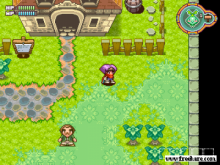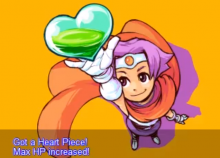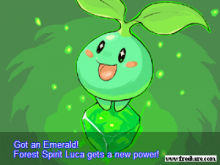Empty Elegy: Guardian of Paradise
Posted on May 05 2013 by Bastian
 Since we’re already out of chronology, I may as well leap past some of the older 8-bit Zelda clones for now and focus on a much more recent retro-styled 16-bit game created as freeware to be played on your PC. And if the picture to the left didn’t make it obvious enough, this game is clearly based not just on the Zelda series in general, but A Link to the Past specifically.
Since we’re already out of chronology, I may as well leap past some of the older 8-bit Zelda clones for now and focus on a much more recent retro-styled 16-bit game created as freeware to be played on your PC. And if the picture to the left didn’t make it obvious enough, this game is clearly based not just on the Zelda series in general, but A Link to the Past specifically.
This week we’ll be talking about the Zelda clone Guardian of Paradise, created by E. Hashimoto–who goes by “Buster” in the indie gaming community–it was originally released only in Japanese. Thankfully, however, some people took it upon themselves to do an English translation, and it was certainly worth it!
Jump inside to learn more about this game!
 If you’ve been following this features series, you’ll know that I try to point out that “clone” doesn’t necessarily hold a negative connotation. While there are certainly games out there who were simply trying to rip off the Zelda series (Neutopia, we’re looking at you!) there are other games out there which are simply copying the gameplay or even the aesthetics of a Zelda game to pay homage and/or to provide a new game in that same genre Zelda has crafted. Guardian of Paradise is one of those. Not only is this top-down action-adventure visually very similar to something we’d see in a Link to the Past/The Minish Cap combo, the puzzles, gameplay, items, and general “vibe” are quite Zelda-like. There is even a section of woods with one repeating screen à la “the Lost Woods.”
If you’ve been following this features series, you’ll know that I try to point out that “clone” doesn’t necessarily hold a negative connotation. While there are certainly games out there who were simply trying to rip off the Zelda series (Neutopia, we’re looking at you!) there are other games out there which are simply copying the gameplay or even the aesthetics of a Zelda game to pay homage and/or to provide a new game in that same genre Zelda has crafted. Guardian of Paradise is one of those. Not only is this top-down action-adventure visually very similar to something we’d see in a Link to the Past/The Minish Cap combo, the puzzles, gameplay, items, and general “vibe” are quite Zelda-like. There is even a section of woods with one repeating screen à la “the Lost Woods.”
Graphics
 I mean, just look at those trees! They look like a hybrid of the top part of the trees seen in The Minish Cap with the bottom half from A Link to the Past. Not only are they the same basic shape and from the same perspective angle, but even the specific details like the fact that there are three roots at the bottom… I’m pretty sure that was intentional and meant to hearken back to A Link to the Past, to tell you: you like A Link to the Past? Here’s some more for you all these years later! Everything about this game, though developed in recent history, is clearly trying to recapture that beautiful simplicity of A Link to the Past in its visuals. The only major difference is that for whatever reason when you acquire a new item it goes to a full screen image of the character holding that item with the usual “You got an item” sort of message. But other than that, the rather stout graphic style cannot help but remind of A Link to the Past, whereas the style of the cliffs and mountains are much more in line with something seen in The Minish Cap.
I mean, just look at those trees! They look like a hybrid of the top part of the trees seen in The Minish Cap with the bottom half from A Link to the Past. Not only are they the same basic shape and from the same perspective angle, but even the specific details like the fact that there are three roots at the bottom… I’m pretty sure that was intentional and meant to hearken back to A Link to the Past, to tell you: you like A Link to the Past? Here’s some more for you all these years later! Everything about this game, though developed in recent history, is clearly trying to recapture that beautiful simplicity of A Link to the Past in its visuals. The only major difference is that for whatever reason when you acquire a new item it goes to a full screen image of the character holding that item with the usual “You got an item” sort of message. But other than that, the rather stout graphic style cannot help but remind of A Link to the Past, whereas the style of the cliffs and mountains are much more in line with something seen in The Minish Cap.
 Gameplay
Gameplay
 But let’s talk about gameplay for a bit. Your primary weapon is the sword and naturally there are times in this lush landscape where bushes block your path, so of course you take a swing at them and a rain of leaves fluttering down is all that remains of them. This is borrowed directly from A Link to the Past. There are cube-shaped blocks which need to be pushed in a certain order (sometimes the exact same order found in Zelda games) to move them out of your way so that you can advance. Or other times there are switches which need to be held down by pushing a block onto it. There are also circular posts which block your path and which can be pounded into the ground with a hammer… And then there are bombs which you use to blast holes in suspicious-looking walls. Of course if you want to increase your life meter, you’ll have to find a a heart-shaped object called a “Heart Piece” which then adds a new unit to your life.
But let’s talk about gameplay for a bit. Your primary weapon is the sword and naturally there are times in this lush landscape where bushes block your path, so of course you take a swing at them and a rain of leaves fluttering down is all that remains of them. This is borrowed directly from A Link to the Past. There are cube-shaped blocks which need to be pushed in a certain order (sometimes the exact same order found in Zelda games) to move them out of your way so that you can advance. Or other times there are switches which need to be held down by pushing a block onto it. There are also circular posts which block your path and which can be pounded into the ground with a hammer… And then there are bombs which you use to blast holes in suspicious-looking walls. Of course if you want to increase your life meter, you’ll have to find a a heart-shaped object called a “Heart Piece” which then adds a new unit to your life.
 The major difference is that while you acquire different “items” which help you solve puzzles, overcome obstacles, and beat bosses… these “items” are actually one of several elemental Spirits. You have one such Spirit equipped at a time and then press a specific button when you want to use that Spirit’s power. The first spirit you meet will instantly conjure a hammer out of nowhere to smash whatever is directly in front of you. Another Spirit will freeze whatever enemy is in front of you into a block of ice which can be used to hold down switches. Besides these button-activated abilities, they each provide you with a passive ability as well, such as being able to swim and such. I’m not sure why the developer decided to complicate things slightly by adding the spirit middleman when they could have just as easily given you those actual items, but ah well, the mechanics are exactly the same. Perhaps this was done so that it was more easy to regulate your Mana points. Each Spirit has their own meter, and the way you replenish any given Spirit’s meter is by finding coins whose color corresponds to that Spirit. The game is often structured in such a way so that this in and of itself is a puzzle: you’ll need to swim across a small body of water, but your water spirit’s meter is drained, but you see some enemies across a pit who you know will drop Water Coins, so you’ll first have to find a way to replenish the meter of the spirit which will allow you to jump across chasms. Also, throughout the game, each spirit basically levels up and can now grant you up to three abilities each. Figuring out which ability to use when is half the fun.
The major difference is that while you acquire different “items” which help you solve puzzles, overcome obstacles, and beat bosses… these “items” are actually one of several elemental Spirits. You have one such Spirit equipped at a time and then press a specific button when you want to use that Spirit’s power. The first spirit you meet will instantly conjure a hammer out of nowhere to smash whatever is directly in front of you. Another Spirit will freeze whatever enemy is in front of you into a block of ice which can be used to hold down switches. Besides these button-activated abilities, they each provide you with a passive ability as well, such as being able to swim and such. I’m not sure why the developer decided to complicate things slightly by adding the spirit middleman when they could have just as easily given you those actual items, but ah well, the mechanics are exactly the same. Perhaps this was done so that it was more easy to regulate your Mana points. Each Spirit has their own meter, and the way you replenish any given Spirit’s meter is by finding coins whose color corresponds to that Spirit. The game is often structured in such a way so that this in and of itself is a puzzle: you’ll need to swim across a small body of water, but your water spirit’s meter is drained, but you see some enemies across a pit who you know will drop Water Coins, so you’ll first have to find a way to replenish the meter of the spirit which will allow you to jump across chasms. Also, throughout the game, each spirit basically levels up and can now grant you up to three abilities each. Figuring out which ability to use when is half the fun.
 Story
Story
The actual story is a tiny bit darker and more personal than your usual Zelda fare: your sister is deathly ill and the only thing which can save her is some enchanted water found in “Paradise”, so off you go to track down this mythical land. However, the general vibe is as cute and comical as any Zelda game. There are creatures which have specific ways of talking. The townspeople are amusing and full of personality. The story might be very simple and straightforward (no dramatic twists or turns at all) but that’s a huge part of the charm, since it recalls a time when games could simply be about defeating a big bad boss or saving your ill sister and that was enough.
If you’re looking for a top-down action-adventure game in the style of Zelda to tide you over until Zelda 3DS is released, you can find out where to download the free game here.




